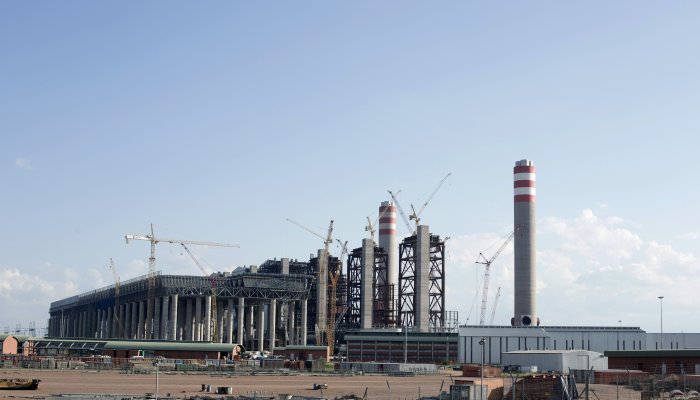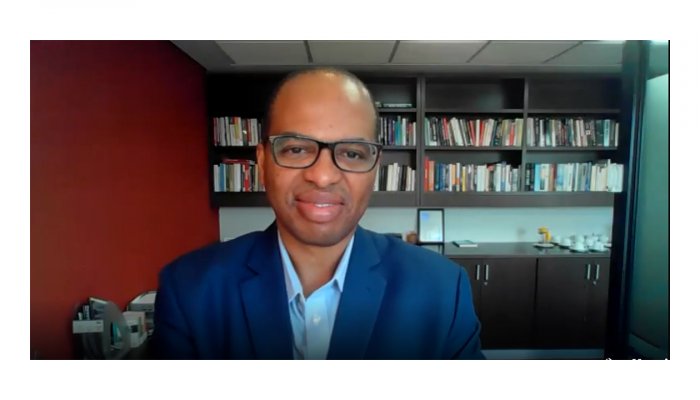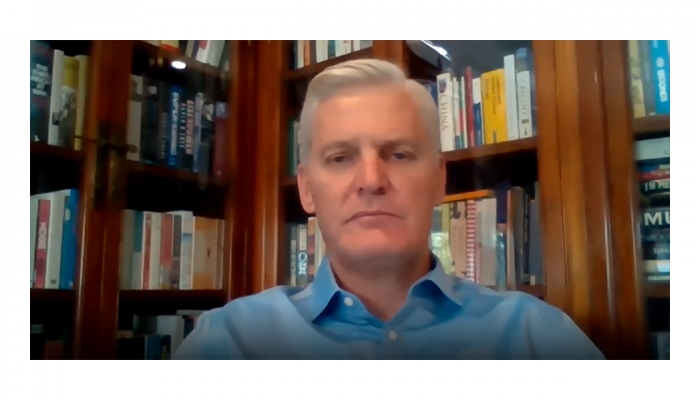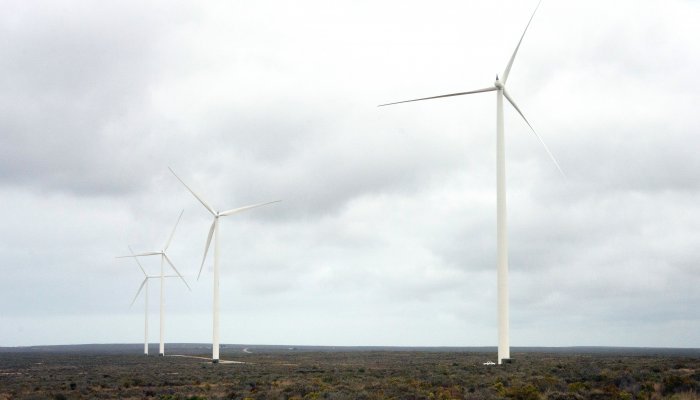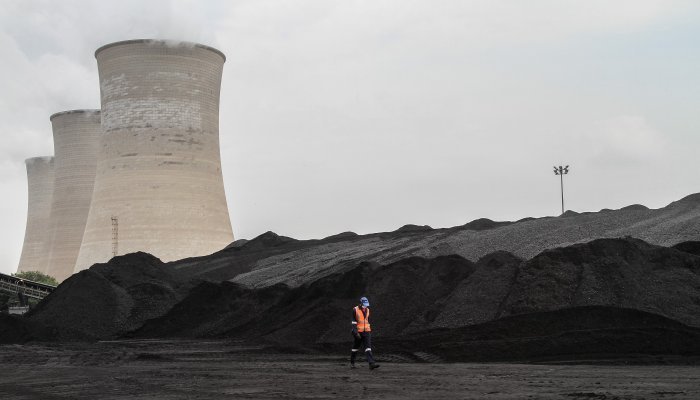Dr. Morris Mthombeni, GIBS interim dean, was in conversation recently with Eskom CEO, André de Ruyter, at a virtual GIBS forum to discuss the current state of the national power utility and its turnaround strategy.
In April 2008, Eskom introduced regular, scheduled, mandatory rolling blackouts, known as load shedding, to maintain its ageing infrastructure across South Africa. This has had a negative impact on South Africa’s economy, diminishing profitability and contributing to credit rating downgrades by the various ratings agencies.
Now, 13 years later, national load shedding is still a huge concern. When Eskom implements rolling blackouts, its 6.7 million customers brace themselves for approximately two to eight hours of intermittent power cuts per day, depending on the scheduled stage of load shedding. At times, Eskom end-users have taken to the social media platform, Twitter, to voice their frustrations, resulting in hashtags #loadshedding and #Eskom trending in the country.
The rolling blackouts have been accompanied by various media reports on corruption, fraud and maladministration at the state utility, resulting in a trust deficit among its stakeholders, employees and customers. Restoring people’s trust would require the resuscitation of the power utility’s corporate values and the simultaneous implementation of “consequence management”, while also recognising excellence within the organisation, said De Ruyter.
Restoring power generation capacity
When De Ruyter took over the reins a year ago, he cautioned that load shedding would likely remain as the 98-year-old power utility rolled out its maintenance plan to replace the power generation capacity of elderly power plants.
“Eskom, today, sits with a fleet of power stations that are, on average, 39 years old. They’ve had a hard life; they have not been well maintained, and the consequence of that is that they are becoming increasingly expensive,” said De Ruyter.
“We have embarked on this reliability maintenance recovery programme, which seeks to restore some of the integrity of our generation system,” he added.
The maintenance programme is expected to lead to a reliable power generation system by mid-year, followed by a reduction in load shedding towards the end of the year.
Escalating debt and electricity tariffs
Eskom currently sits with a R480 billion debt burden, some of which is owed by municipalities severely in arrears.
Eskom requires R1 billion worth of support from the government per week to remain operationally and financially stable in 2021, according to a presentation made to parliament in March.
The cross-country transportation of coal to power stations is one factor contributing to the rising cost of coal and thus electricity tariff hikes, said De Ruyter.
In February this year, the National Energy Regulator of South Africa approved Eskom’s application for a 2021/22 tariff increase, which will see Eskom customers pay an additional 15% for electricity this year.
“Unfortunately, in order to enable Eskom to be financially self-sustaining, the tariffs need to increase,” said De Ruyter, noting that it made economic sense to recover money from Eskom end-users who consumed electricity, at their discretion, versus diverting money from government priorities.
Exporting power supply not detrimental to SA consumer
Eskom is also a net exporter of energy beyond South Africa’s border under the Southern African Power Pool (SAPP), a partnership with countries within the Southern African Development Community (SADC), including South Africa, Botswana, eSwatini, Lesotho, Mozambique, Namibia, Zambia and Zimbabwe.
The SAPP is an integrated grid that serves to support grid stability and is reliant on SADC member partnerships to ensure sufficient and reliable transmission grids in member countries.
As part of the SAPP partnership, South Africa also imports a significant amount of electricity from Mozambique, which is in line with international practice, said De Ruyter.
He rectified the narrative that the net export of electricity beyond South Africa’s borders was at the expense of its South African customers. “There is no way that we will disadvantage South Africa and our South African customers in order to keep the lights on in Zimbabwe and Zambia,” he said. “We make money, and we are making that money by exporting electricity. We actually subsidise South African electricity sales, so that puts a damper on the cost of electricity that we sell domestically.”
According to Eskom’s 2020 integrated annual report, the power utility’s recovery efforts resulted in the full settlement of the arrear debts of ZESCO of Zambia and ZETDC of Zimbabwe. The only outstanding “doubtful debt”, said De Ruyter, was that of EDM from Mozambique, which still had an outstanding amount of R550 million (with 91% overdue) as at 30 March 2020.
Gearing up towards a sustainable energy mix
The past decade has seen a significant number of businesses and households make a gradual migration towards sustainable renewable energy sources such as wind and solar power. These once expensive energy alternatives have since become more affordable and are currently in direct competition with coal-dependent Eskom.
Most of Eskom’s power stations were built under less stringent environmental regulation and legislation. And as the world continues to advocate for consciousness and climate change, coal-burning Eskom is under mounting pressure to comply with the environmental regulation and legislation amendments.
Eskom will continue as a large consumer of coal for a lengthy period, said De Ruyter, but the generation capacity of retiring power stations will be replaced with renewable energy. Power stations in their mid-life cycle will be made compliant with the emission regulation, an exercise that will require Eskom to spend R300 billion over the next decade.
“We are working reactively on a programme to repurpose and to re-energise using a combination of PV [photovoltaics], wind and natural gas in order to use the existing infrastructure and in order to abate some of the environmental compliance expenditure,” said De Ruyter.
“We would rather spend that R300 billion on putting in place new generation capacity that does not require environmental abatement, than to spend it on something that does not add one megawatt of additional generation capacity,” he added.
Eskom has expressed its support for the Department of Mineral Resources and Energy’s (DMRE) procurement programme to add some 11,800 megawatts of new electricity generation infrastructure under the Integrated Resource Plan 2019, and 2,000 megawatts of emergency procurement.
“We are working with the DMRE to enable this,” said De Ruyter. “And we have a period of time during which we are managing the risk to the system in as responsible a way as possible. As soon as this additional capacity gets put onto the grid, we think the risk of load shedding will be something of the past.”
Eskom workforce competency and skills transfer plans
As the conversation flowed, Dr. Mthombeni asked the Eskom CEO where the power utility measured in terms of its competency assessment, given that over the years they had lost a significant number of employees for a variety of reasons, some of which included corruption.
De Ruyter said he was “comfortable” with Eskom’s capabilities in addressing its current challenges. He further added that there were initiatives to facilitate the knowledge transfer where requisite skill levels were found wanting within the organisation.
Eskom has a strong track record of investing in a pipeline of talent through its bursary schemes and training programmes. Some of the talent includes engineering graduates with Master’s and PhD qualifications who are likely to benefit from the power utility’s skills transfer initiatives set to bridge the gap between academic theory and on-the-job training.
“We have identified experts in Eskom,” said De Ruyter, “And we are leveraging these pockets of excellence to identify best practise across the organisation and then roll it out so that we can learn from each other. This is an exciting programme, and I think there is a lot of appetite because in transferring knowledge, you empower and create an environment where people can learn in a non-threatening manner.”
Reducing Eskom’s bloated staff complement
Findings of a 2016 World Bank1 study shone the spotlight on Eskom’s bloated staff complement, stating that the state-owned enterprise was potentially 66% overstaffed compared to other power utilities worldwide.
De Ruyter said the report had been rebutted since it used benchmarks that “weren’t entirely relevant” to Eskom. “With a lot of respect for the World Bank,” he said, “I think the number that got put out there created this perception that we had two to three people per job in Eskom, and that is not true. We think that an appropriate level would be at about 38,000 employees, given the size and scale of our operation, bearing in mind that we run generation, transmission and distribution.”
De Ruyter said that when he joined Eskom in January 2020, the national power utility had approximately 46,000 employees, and through a series of voluntary severance packages, the number has been reduced to 44,000.
His hope is for Eskom employee numbers to undergo a further reduction to 38,000 by 2024 without resorting to retrenchments under Section 189 of the Labour Relations Act.
“We think that this is an ideal balance where we can maintain appropriate skill levels. Obviously, you don’t want your best people to leave, so there’s a requirement, especially with the severance packages, that if the skill is required by Eskom, then we are not going to allow you to take the package because the interests of the employer have to come first,” said De Ruyter.
As the wheels of change continue to turn at Eskom, De Ruyter remains hopeful about the future of the state utility.
“I think we are building the momentum. I see change accelerating. I see people engaging within Eskom and doing the right things on a daily basis, and that’s encouraging and is positive,” he said.
“Certainly, I am optimistic that this is doable and that we can turn Eskom around,” he concluded.
1 https://www.engineeringnews.co.za/print-version/world-bank-says-eskom-simply-too-big-to-fail-2019-01-22


